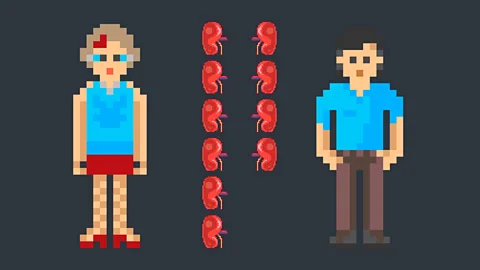Why do more women donate organs than men?
 Getty Images
Getty ImagesSix in 10 kidney donors are women – but some 6 in 10 recipients are men. This may have health consequences for both genders.
By 2016, my mother’s kidneys had started to fail – again. Her first transplant had come from a cadaver she matched with after several years on the waitlist. But this time around, her youngest sister was ready. She chose to be my mother’s donor.
As a woman donating to a loved one, my aunt fits the basic description of most kidney donors. Women make up around 60% of living kidney donors in the US; other countries report similar numbers. This gender difference is growing. Since 2008, the number of male donors has decreased in every demographic. But most patients awaiting a transplant – 59% – are men.
 BBC/Getty
BBC/GettyThe fact that more men need kidneys, but more women give them, doesn’t just mean an extra burden on women. It could have potential health consequences for men too.
You might also like these other stories in the Health Gap:
• The mystery of the pelvic floor
There is conflicting data about whether or not gender mismatch has an effect on the success of a transplant. But one study of more than 230,000 US organ donations from 1998 to 2012 showed that female-to-male kidney transplants were among the least likely to succeed. This trend is seen with other organs, as well: men who received a heart from a female rather than male donor, for example, had a 15% higher chance of dying within the next five years.
One reason that gender may play a role is the differing organ size. For some organs, “size is very important”, says Rolf Barth, head of the Division of Transplantation at the University of Maryland Medical Center. For larger people, he says, “you wouldn’t want a smaller kidney” since smaller organs are less likely to keep up with the demands of a larger body. One analysis of more than 115,000 kidney recipients, for example, found that the risk of graft failure was highest when a recipient weighed more than 30kg more than the donor.
 BBC/Getty
BBC/GettyEven if a woman and man weigh the same, though, a woman’s organs still tend to be smaller. But often the only size-related aspect taken into is body weight – which could contribute to some of the gender mismatch risk. The same graft failure analysis found that a female donor-male recipient pairing had the same risk as when the recipient weighed 10-30kg more than the donor. For heart donations, meanwhile, researchers found that using a more precise model than body weight to predict cardiac mass made the risk of female-to-male donations disappear.
Aside from size, another issue is that men and women’s bodies have different antigens. But new medical advancements have meant that that is becoming less of a problem, says Barth. “In the modern era, we use more intense induction immunotherapies,” he says. “These differences about matching and gender have been minimised.”
 BBC/Getty
BBC/GettySo although much of the current literature still suggests that sex mismatch impacts the success of transplants, studies suggest immunosuppressant drugs can be sufficiently tailored for it to be worth the risk.
There are other gender-related inequalities in organ donation, too. One study of 101 urban black patients found that women on dialysis were less likely to be evaluated for kidney transplantation than men on dialysis. They also were less likely to want a kidney transplant – despite receiving more offers than men. Meanwhile, a much larger study of more than 700,000 patients found an odd gender disparity in of body mass index: while overweight women were significantly less likely to receive transplants than their thinner counterparts, overweight men were more likely to receive transplants.
It isn’t clear what causes those disparities. But there are some solid theories about why so many more women than men donate.
One reason is simple. Spouses are often the first to volunteer to donate a kidney to their loved one. And while women are more likely to get chronic kidney disease, men are more likely to be treated for end-stage renal failure – meaning of heterosexual couples, more wives than husbands may feel compelled to step up. In a study of 631 living kidney donors in Switzerland, for example, 22% were female life partners while 8% were male partners.
 BBC/Getty
BBC/GettyBut that doesn’t for all of it. Women also far outstripped men in donating to their children, a sibling or another family member, for example.
Another reason may be economic. Donors need to take several weeks off of work for the surgery and recovery process, and the US healthcare system has nothing in place to make that sacrifice financially neutral. My aunt, who had to forego income during her four-week recovery period, estimates that she lost a total of $8,000 to $10,000. Even in countries like Switzerland, where loss of income is reimbursed, istrative hurdles mean that getting payments can take weeks. Men, who remain more likely to be the sole breadwinner in their household, may be less likely to give as a result.
This is especially pronounced for lower-income families. Only recently have researchers begun to examine how much loss of income is affecting the rates of kidney donation.
But not everyone agrees that the disparity is because families are less reliant on women for income.
“Women, regardless of their work status, are the caregivers for their family, and they see what their family member goes through with dialysis,” says Cathy Klein-Glover of the University of Maryland Medical Center. “And just because of that role, they’re more likely to say, ‘I’m going to step up and be the resolution to the problem’.”
 BBC/Getty
BBC/GettyAs the transplant clinical team lead, it is Klein-Glover’s job to evaluate potential donors and determine whether they’re good candidates for organ donation, with the right social in place to ensure a successful recovery.
In her experience, she says, “women are more likely to see themselves as the solution” to the problem than men.
Self sacrificing
In general, women are more socialised to see caring for their family as an extension of their domestic duties. This, experts say, may be the main driving force of the disparity.
“There is a general social expectation that women will be givers,” says Bethany Foster, a physician who focuses on kidney research at McGill University in Canada.
This lines up with what medical anthropologists discovered when they conducted a study of attitudes towards living organ donation in Egypt and Mexico. Both cultures placed especially high expectations on mothers to donate their organs to their children, and conflated motherhood with a willingness to donate.
“Drawing a resonant analogy between giving birth and giving a kidney, mothers’ bodies were explicitly envisioned as the source of life from which both fully formed babies and organs could be extracted,” the study says. “Taking one more organ from that same source was rendered an organic continuation of that bodily intimacy and interdependence.”
 BBC/Getty
BBC/GettyIn fact, many of the female donors Klein-Glover has interviewed are willing to donate because they’ve already experienced a major medical event like childbirth. As a result, she says, “they trust the medical system. Sometimes they’ll say to me, ‘Compared to what I’ve been through, this doesn’t seem bad at all.’”
But there is an underlying irony: having been pregnant is yet another of the biggest complicating factors of organ donation for women who want to donate or need a transplant.
One of the biggest challenges for a successful transplant is making sure that the recipient’s immune system doesn’t reject the organ. But a mother’s blood is exposed to her fetus’s antigens – which can make her match less closely to her own blood relations. As a result, some studies have suggested that pregnancy, which is what doctors refer to as a “sensitising event”, is why women may have a harder time finding a match within their own family. (In my own family, I have another aunt who was considered less of an ideal match for my mother because she has two children.)
In the future, experts say, they hope that more research and attention from the medical community can dispel some of the cultural and financial barriers in place when it comes to organ donations.
“Hopefully this will make people think of themselves as donors,” says Klein-Glover – regardless of cultural expectations.
This story is part of the Health Gap, a special series about how men and women experience the medical system – and their own health – in starkly different ways.
Do you have an experience to share? Or are you just interested in sharing information about women's health and wellbeing? our Facebook group Future Woman and be a part of the conversation about the day-to-day issues that affect women’s lives.
If you liked this story, sign up for the weekly bbc.com features newsletter, called “If You Only Read 6 Things This Week”. A handpicked selection of stories from BBC Future, Culture, Capital, and Travel, delivered to your inbox every Friday.
